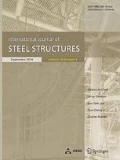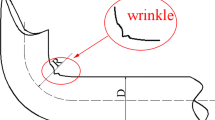Abstract
The buckling and sudden capacity loss of the compression member can be prevented using a proposed tube in tube force limiting device (TTFLD). In this way, the brittle post-buckling behavior of the compression member can be converted into an elasto-plastic behavior. The TTFLD consists of two tubes with unequal diameter, one of which is placed into the other tube. The outer tube operates as a casing for the inner compression tube and the flexural stiffness of the outer tube restrains the buckling of the inner tube. The present study has experimentally investigated and evaluated a number of experimental specimens. Next, numerical analysis of these specimens has been done using finite element software. Further, the behavior of the tube in tube force limiting device have been investigated under important parameters such as the gap between the inner and outer tubes (gap), the inner tube or main member slenderness ratio (λ), and the ratio of outer tube length to inner tube length \(\left( {L_{2} /L_{1} } \right)\), by extending the numerical studies to further examples. Using this TTFLD is an effective, simple and economical method to prevent the buckling of compression member and can lead to a favorable increase in the bearing and deformability capacity of the compression members with different values of slenderness ratio. The compressive strength of the member will increase significantly, if the gap size is less than about 43% of the inner tube’s gyration radius, and the length ratio is greater than about 55%.

























Similar content being viewed by others
References
ABAQUS/CAE 6.13 Software. (2013). Dassault Systems Simulia Corp. Providence, RI.
American Institute of Steel Construction (AISC). (2016). Seismic provisions for structural steel buildings. ANSI/AISC 341, Chicago, IL.
Dehghani, E., Babaei, N., & Zarrineghbal, A. (2019). Investigation of the distribution of cumulative ductility demand parameter in various storeys of buckling restrained braced frames. Journal of Rehabilitation in Civil Engineering,7(3), 148–161.
Ding, Y., Zhang, Y., & Zhao, J. (2009). Tests of hysteretic behavior for unbonded steel plate brace encased in reinforced concrete panel. Journal of Constructional Steel Research,65(5), 1160–1170.
El-Sheikh, A. (1999). Effect of force limiting devices on behaviour of space trusses. Engineering Structures,21(1), 34–44.
Hanaor, A., & Schmidt, L. C. (1980). Space truss studies with force limiting devices. Journal of the Structural Division,106(11), 2313–2329.
Inoue, K., Sawaizumi, S., & Higashibata, Y. (2001). Stiffening requirements for unbonded braces encased in concrete panels. Journal of Structural Engineering,127(6), 712–719.
Iwata, M., Katoh, T., & Wada, A. (2001). Performance evaluation of buckling-restrained braces on damage controlled structures: Parts 1 and 2. In Summaries of technical papers of annual meeting, Architectural Institute of Japan, Structural Engineering Section (III) (pp. 658–662) (in Japanese).
Iwata, M., & Murai, M. (2006). Buckling-restrained brace using steel mortar planks; performance evaluation as a hysteretic damper. Earthquake Engineering and Structural Dynamics,35(14), 1807–1826.
Kim, C. H., & Chae, W. T. (2015). A study on the development of force limiting devices of cross-section cutting types. Journal of Korean Society of Steel Construction,27(1), 77–85.
Kim, C. H., Chae, W. T., & Do, C. G. (2014). A study on the development of the force limiting device with folded types. In Proceedings of annual conference Korean society of steel construction, KSSC (pp. 113–114) (in Korean).
Kim, C. H., Chae, W. T., Oh, Y. S., & Kim, C. Y. (2013). A study on the development of force limiting devices (FLD) which Induce yielding before elastic buckling. Journal of Korean Society of Steel Construction,25(3), 279–287. (in Korean).
Mukai, H., Wada, A., Watanabe, A., & Iwata, M. (1993). Ductile truss structures and scaled model experiments. In Space structures 4 (pp. 1841–1850).
Narihara, H., Tsujita, O., & Koeteka, Y. (2000). The experimental study on buckling restrained braces (Part 1: Experiment on pin connection type). In Summaries of technical papers of annual meeting, Tokyo: Architectural Institute of Japan (Vol. 9, pp. 911–912).
Oh, Y. S., Kim, C. H., Kim, C. Y., & Chae, W. T. (2013). A study on the post-buckling behavior of slit type FLD (force limiting device). Journal of Korean Society of Steel Construction,25(5), 475–486. (in Korean).
Poursharifi, M., Abedi, K., & Chenaghloua, M. (2017). 05.32: Experimental and numerical study on the collapse behavior of an all-steel accordion force limiting device. Ce/papers, 1(2–3), 1315–1324.
Rahman, Md. S., Begum, M., & Ahsan, R. (2016). Comparison between experimental and numerical studies of fully encased composite columns. International Journal of Structural and Construction Engineering, 10(6).
Riks, E. (1979). An incremental approach to the solution of snapping and buckling problems. International Journal of Solids and Structures,15(7), 529–551.
Satake N., Mase S., Terada T., & Isoda K. (2001). Development of unbounded brace damper restrained by channel section steel (Part 2 static loading test using full-scale specimens). In Summaries of technical papers of annual meeting, Architectural Institute of Japan (Vol. 9, pp. 665–666).
Schmidt, L. C., & Hanaor, A. (1979). Force limiting devices in space trusses. Journal of the Structural Division,105(5), 939–951.
Watanabe, A., Hitomi, Y., Saeki, E., Wada, A., & Fujimoto, M. (1988). Properties of brace encased in buckling-restraining concrete and steel tube. In Proceedings of ninth world conference on earthquake engineering (Vol. 4, pp. 719–724).
Wu, B., & Mei, Y. (2015). Buckling mechanism of steel core of buckling-restrained braces. Journal of Constructional Steel Research,107, 61–69.
Author information
Authors and Affiliations
Corresponding author
Additional information
Publisher's Note
Springer Nature remains neutral with regard to jurisdictional claims in published maps and institutional affiliations.
Rights and permissions
About this article
Cite this article
Ghalejoughi, J., Sheidaii, M.R. & Tariverdilo, S. Experimental and Numerical Study of a Tube in Tube Force Limiting Device. Int J Steel Struct 20, 1405–1419 (2020). https://doi.org/10.1007/s13296-020-00372-y
Received:
Accepted:
Published:
Issue Date:
DOI: https://doi.org/10.1007/s13296-020-00372-y




